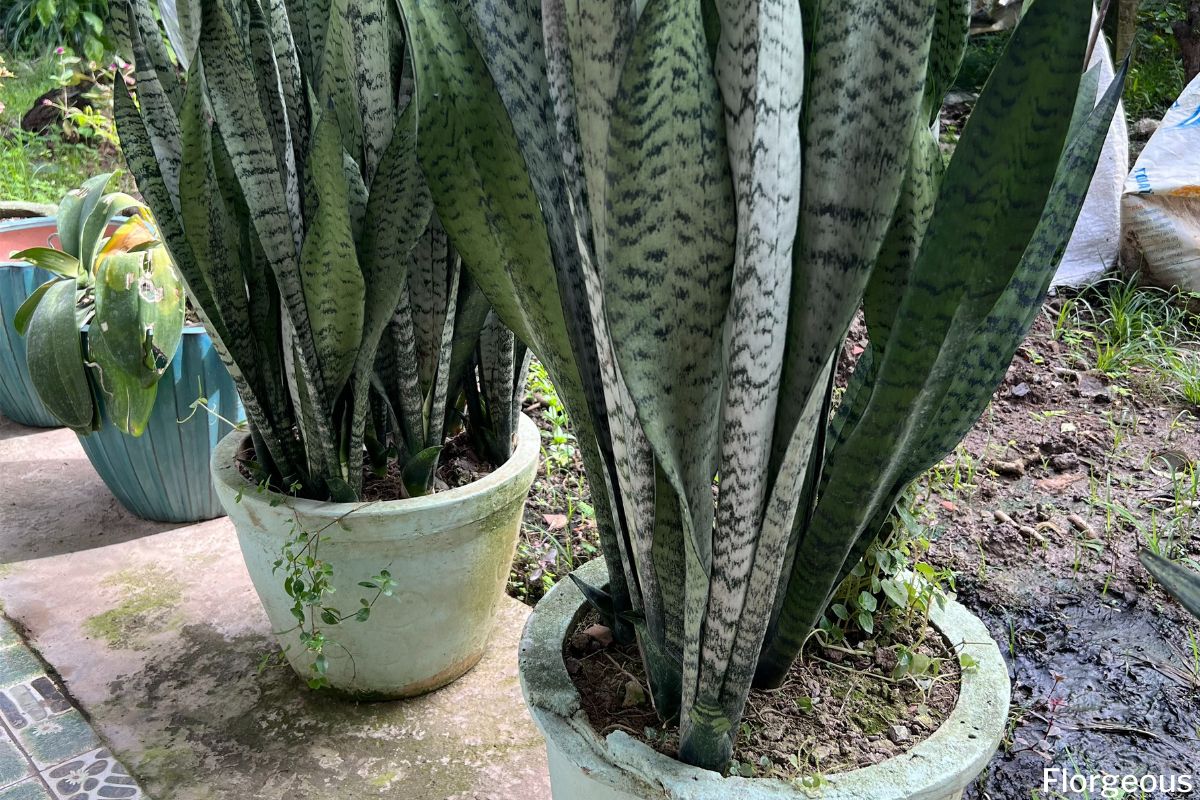Watering Snake Plants: A Seasonal Guide is your key to unlocking the secrets of keeping these resilient plants thriving year-round. Snake plants, known for their striking vertical foliage, are surprisingly low-maintenance, but their water needs can vary dramatically with the changing seasons.
Understanding these seasonal shifts is crucial for maintaining their health and ensuring they continue to add a touch of elegance to your home.
From the increased growth spurts of spring to the dormancy of winter, each season presents unique challenges for watering snake plants. This guide will equip you with the knowledge to provide the perfect amount of hydration, preventing both overwatering and underwatering.
Introduction: Watering Snake Plants

Snake plants, scientifically known asSansevieria trifasciata*, are popular houseplants renowned for their hardiness and resilience. Their upright, sword-like leaves add a touch of architectural elegance to any indoor space. However, their low-maintenance reputation can be deceiving when it comes to watering.
Snake plants have unique water requirements, and understanding these nuances is crucial for their long-term health and vitality. One of the most common mistakes made by plant owners is overwatering, which can lead to root rot and ultimately, plant death.
Unlike many other houseplants, snake plants prefer to be slightly dry between waterings. Their thick, fleshy leaves store water, allowing them to tolerate periods of drought.
Seasonal Adjustments for Watering Snake Plants
The frequency of watering snake plants should be adjusted based on the seasons. During the active growing season, typically from spring to fall, snake plants require more frequent watering. As temperatures rise and sunlight intensifies, the plant’s metabolic processes increase, leading to higher water consumption.
Just like the careful selection of a pot plays a crucial role in a bonsai’s health, understanding the optimal watering frequency for snake plants is essential for their thriving. While snake plants are known for their resilience, they still require proper hydration, and the frequency of watering should be adjusted based on the season.
How to Choose a Bonsai Pot That Promotes Healthy Growth provides valuable insights into choosing the right pot for your bonsai, and similarly, understanding the seasonal changes in watering needs for snake plants is key to their long-term health.
However, during the winter months, when growth slows down and sunlight is less intense, snake plants require less frequent watering.
Watering Snake Plants in Spring

Spring marks a period of renewed growth for snake plants, as they emerge from their winter dormancy and begin actively producing new leaves. This increased growth translates to a higher demand for water, requiring a change in your watering routine.
Determining Watering Frequency
The frequency with which you water your snake plant during spring depends on several factors, including sunlight exposure, soil type, and the plant’s overall size.
- Sunlight Exposure:Snake plants that receive more sunlight will require more frequent watering than those kept in shady locations. Increased sunlight leads to faster transpiration, which is the process of water loss through the leaves. This necessitates more frequent watering to replenish the lost moisture.
- Soil Type:Different soil types retain moisture at varying rates. Well-draining potting mixes, like those with perlite or pumice, allow water to flow through quickly, requiring more frequent watering. Conversely, denser soils that retain moisture for longer periods may only need watering every few weeks.
- Plant Size:Larger snake plants have a greater root system, enabling them to absorb and retain more water. Consequently, they may require less frequent watering compared to smaller plants.
Watering Snake Plants in Autumn: Watering Snake Plants: A Seasonal Guide

As the days grow shorter and the weather cools down, your snake plant’s water requirements will gradually decrease. Autumn marks a transition period for your snake plant, requiring adjustments to your watering routine.
Watering Snake Plants: A Seasonal Guide explores the optimal watering frequency for these resilient houseplants throughout the year. Just as the right pot is crucial for a bonsai tree’s growth cycle, Choosing the Right Bonsai Pot for Your Tree’s Growth Cycle guides you to select the perfect container to promote healthy growth.
Similarly, understanding the seasonal changes in watering needs will ensure your Snake Plant thrives, regardless of the time of year.
Monitoring Soil Moisture Levels
During autumn, it’s crucial to monitor your snake plant’s soil moisture levels closely. As temperatures drop, the plant’s metabolic activity slows down, leading to reduced water absorption. Therefore, you’ll need to water less frequently to avoid overwatering.
- Use a moisture meter:A moisture meter is a handy tool that provides an accurate reading of the soil’s moisture content. Insert the probe into the soil near the plant’s base and check the reading. If the meter indicates moist soil, hold off on watering.
- Check the soil surface:If you don’t have a moisture meter, you can check the soil surface with your finger. If the top inch of soil feels dry to the touch, it’s time to water. However, avoid overwatering, as this can lead to root rot.
Adjusting Watering Frequency, Watering Snake Plants: A Seasonal Guide
With the decrease in temperatures and sunlight, your snake plant’s water needs will reduce significantly. It’s essential to adjust your watering frequency accordingly to prevent overwatering.
- Reduce watering by half:As a general rule of thumb, reduce your watering frequency by half compared to the summer months. However, always monitor the soil moisture levels and adjust the watering schedule based on your plant’s specific needs.
- Water deeply but infrequently:Instead of frequent shallow watering, it’s better to water deeply but less often. Allow the soil to dry out completely between waterings. This practice encourages strong root growth and prevents overwatering.
Avoiding Overwatering
Overwatering is a common problem during autumn, as the plant’s water requirements decrease. Overwatering can lead to root rot, which can be fatal for your snake plant.
- Signs of overwatering:If you notice yellowing leaves, wilting, or a foul odor coming from the soil, it could be a sign of overwatering. In such cases, reduce watering immediately and allow the soil to dry out completely before watering again.
- Repotting:If overwatering has led to root rot, you may need to repot your snake plant in fresh, well-draining soil. Carefully inspect the roots and remove any damaged or rotten ones. Repot the plant in a pot with drainage holes to prevent waterlogging.
Watering Snake Plants in Winter
Winter is the time when snake plants enter a period of dormancy, significantly reducing their growth rate and water requirements. Understanding their winter needs is crucial for keeping them healthy and preventing root rot.
Watering Frequency and Amount
During winter, snake plants need much less water compared to other seasons. The goal is to keep the soil slightly moist, but not soggy. Overwatering is the biggest threat during winter, as the plant’s reduced metabolic activity makes it difficult to absorb excess water.
- Water only when the top inch of soil feels dry to the touch. This could be as infrequent as once every 4-6 weeks, depending on the temperature and humidity of your home.
- When you do water, use a small amount of water, just enough to moisten the soil thoroughly. Allow the excess water to drain out of the pot to prevent root rot.
Signs of Underwatering
While overwatering is a greater risk in winter, underwatering can also occur. Here’s how to recognize the signs:
- Leaf wilting:The leaves will become limp and droopy, especially the lower leaves. This is a sign that the plant is not getting enough water.
- Leaf discoloration:The leaves may turn yellow or brown, indicating that the plant is stressed due to lack of water.
- Soil dryness:The soil will feel completely dry, even several inches down.
Responding to Underwatering
If you notice signs of underwatering, water the plant thoroughly, allowing excess water to drain out. It may take a few days for the leaves to recover their turgidity. If the plant has been severely underwatered, you may need to repot it in fresh soil to ensure proper drainage.
Final Summary
Mastering the art of watering snake plants based on the seasons is a rewarding journey that ensures your plants flourish. By paying attention to the subtle cues they provide, you can create an ideal environment for their growth, resulting in lush, vibrant foliage that will brighten your home for years to come.
Remember, consistency and observation are key to success. Embrace the seasonal dance of watering, and your snake plants will reward you with their enduring beauty.
Clarifying Questions
How often should I water my snake plant?
The frequency depends on the season, sunlight exposure, and pot size. Generally, water when the top inch of soil is dry.
What are the signs of overwatering a snake plant?
Yellowing leaves, mushy stems, and a foul odor are common signs.
My snake plant is drooping. Is it underwatered?
While underwatering can cause drooping, it could also be due to other factors like low humidity or root issues. Check the soil moisture first.
Can I use tap water for my snake plant?
Yes, but allowing tap water to sit for 24 hours before watering helps reduce chlorine levels.
How do I repot my snake plant?
Repot in spring or summer using a well-draining potting mix. Choose a pot only slightly larger than the current one.
